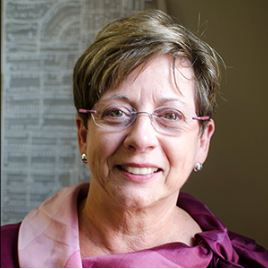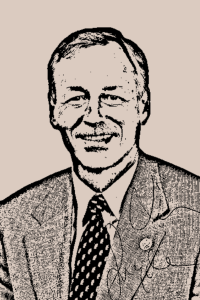By Becca Bona
Higher education administration is not for the fainthearted, and the profession’s career path is not always clear. Upon looking back, Dr. Deborah Baldwin holds that academia wasn’t necessarily her chosen track. “I didn’t even have aspirations to be a college professor at first,” she details.
Choosing the life of a professor, discovering Little Rock
Growing up in Indianapolis, Baldwin planned on staying in state for her collegiate studies. She attended Ball State and focused on history, with the idea that she would teach when she graduated.
She got her teaching certificate in history as well as biology and chemistry to ensure she had job prospects after graduation, but luckily she ended up in graduate school instead. “Thank goodness I never had to teach biology or chemistry,” she laughs.
She was accepted to the University of Chicago, and chose a course in furthering her studies in history. “I decided that I would take that path, not knowing very much about what taking that path meant,” she says.

Upon starting her studies she discovered she had to specialize as well as pass a language. “I like to tell people that I entered the study of Mexican History because I thought this through very carefully and it was logical … when in fact, it wasn’t.”
After some time in the program she traveled to New Haven, Conn., armed with a sewing machine and a need for a break. Instead of a single summer, she spent a full year there, holding various jobs including: teaching at a mental health hospital, at a center for unwed mothers, and in a program for at-risk teenagers.
“It was great training for being a dean in my later years,” she jokes. Later, when she landed at UALR she would draw back on these experiences. “I was always attracted to a notion of teaching in a metropolitan setting in a metropolitan school that identified with the city.”
After moving from Chicago to Tempe, Ariz., Baldwin received a call from UALR about an open position within their history department. She interviewed and subsequently moved in 1980.
The beginning was rough, mainly because she and her husband rented a house, sight unseen from the newspaper, and neglected to ask about appliances. After the long journey the two had to locate a refrigerator.
“When I moved here I never intended to stay long-term,” she explains; but she found that she was “pleasantly surprised by a number of things.”
One of them was the willingness of those at UALR to try new things and have an open mind. “I was almost never told no when I proposed something at UALR,” she says, “It was engaging.”
At the time the history department was full of other transplants from across the country, which helped with Baldwin’s transition to the capital city. She and her husband eventually moved to Hillcrest, a neighborhood she still loves to this day.
She also had opportunities to satiate her love of research and travel. “We weren’t overly generous with travel money, but I always had travel money so I could go to Mexico. Very soon after I arrived we started an exchange program in Guadalajara, as well.” With all of the possibilities spread before her at UALR and within Little Rock, Baldwin began to think she may have found a home.
Deciding to stay
After a few years Baldwin became more involved within the department and the university as a whole. She remembers when she first became department chair. “There were other professors who urged me to consider becoming chair of the department.” In particular she remembers the late T. Harri Baker as being a mentor. When she was elected chair of the department, she remembers the school newspaper beefing up the news. “I was the only woman who was chair at the time and the school newspaper did a front page article … that tells you how unusual and long ago it was,” she laughs.
Despite her cautious acceptance, Baldwin enjoyed the job. “Harri and others were very supportive. It was funny because I didn’t covet the job, so every time I wanted someone to help me do something, … they knew I would just quit being chair if they didn’t come along and help.”
After serving three years as department chair, she thought her administration days were over. However, she ended up as interim dean about a year afterwards. At the time, UALR was performing a national search to fill the position, and Chuck Hathaway, yet another mentor, encouraged Baldwin to put her name in the pool. She did, “right at the last minute,” and was selected as the new dean.
Wanting to leave an impact during her time as dean, Baldwin put focus on technology and eventually, what would become the Center for Arkansas History and Culture. “I was particularly interested into getting technology introduced in core classes,” she says, and to this day is proud of the strides made in that realm.
Discovering Arkansas through the Center for Arkansas History and Culture
These days Baldwin has moved over to the Center for Arkansas History and Culture fulltime, holding the title of associate provost of UALR’s collections and archives. Baldwin credits the chancellor and Central Arkansas Library Director Bobby Roberts for having the foresight to forge a partnership over historic archives. Their idea of renovating the building adjacent to the main library downtown and providing one location for researchers was a smart one.
When the building opened in 2009, Baldwin remembers, “What wasn’t very clear at that point was how we were all going to operate the facility.” The chancellor asked her to consider moving to the downtown office after realizing the CAHC wasn’t at its full potential.
That was nearly four years ago, and Baldwin had to be asked again, as she was armed with a few questions of her own. “I said well, I’m quite interested, but I’m also quite interested to know what the vision is for down here.”
Once she discovered there was room for growth, she immediately had plans to work with different departments and get more student activity there. Baldwin briefly explains the CAHC: “It’s a place that collects and preserves and makes accessible historic documents like any archives, but beyond that it’s also a place that brings people in through its events and activities by having fun and learning about the place they live.”
While local gubernatorial papers are housed within the collections, such as Winthrop P. Rockefeller, the archives also hold information about various groups and organizations from the past, including historic city plans and buildings.
The CAHC now has four full time archivists and three administrative staff, and their hard work shows. This past year they applied for ten grants, and received nine of them. One, from the National Historical Publications and Records Commission, totaled a little over 135,000 alone, and is the largest NHRPC award to date in Arkansas. Her enthusiasm and confidence in her team shows, as she says, “People work extremely hard and are really excited about it.”
When she took on the title of associate provost, Baldwin first focused on getting the center involved with the main campus and vice versa. “We are now holding classes down here and are partnering with faculty on campus, not just in history but in a number of other disciplines,” she explains.
Along that note, the CAHC has become a connector and an information hub for UALR, but also for other educators out there. One way the CAHC creatively conducts educational outreach is through technology.
“Almost any major project that we have done, we have also developed virtual exhibits to accompany them. The nice thing about a virtual exhibit is that it reaches a wider audience,” she explains. These exhibits also act as materials for educators, as she continues, “All of the virtual exhibits have links for teachers with curriculum guides and other materials.”
Baldwin is also excited about the recently completed digital services lab, which utilizes technology to restore old films to a DVD. This is good for outreach and can possibly create a small revenue stream for the center. “We’re starting to get other museums and archives making inquiries about our digitizing materials for them,” she says.
The future for the CAHC is to increase the collection holdings, as well as to develop underrepresented groups. For instance, Baldwin says, “One that we would really like to get into are the Hispanic communities … they’ve got a long history but the increase in those numbers is relatively recent.”
When not working on grants, trying to secure new archive holdings, or discussing finding-aids, Baldwin likes to support the local arts. “I will attend many arts events. I think it’s a part of the culture that’s important for a city.”
She also spends every Sunday with a group of students from Mount St. Mary Academy’s Odyssey of the Mind team which she has headed for over 15 years. Last year, her team won 5th at World Competition, and like anything Baldwin commits herself to, this year the sky is the limit.
To view digital exhibits or to discover upcoming CAHC events visit: https://ualr.edu/cahc/. This article was originally published Tuesday, November 25, 2014 by the Daily Record.

